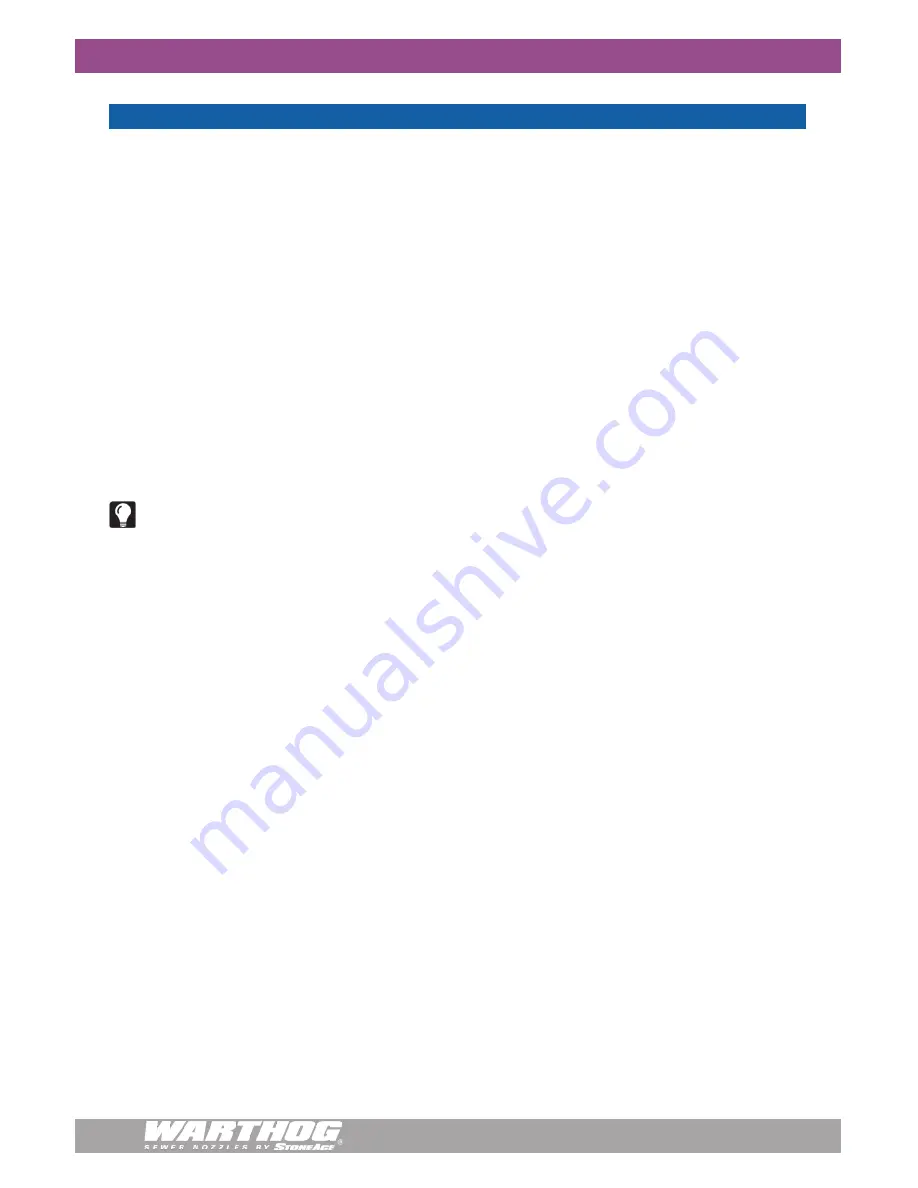
8
866-795-1586 • WWW.SEWERNOZZLES.COM
OPERATION
NOTICE
The two most important items in maintaining the WT tools;
- Keep debris from entering the tool and preventing it from rotating by flushing hoses before use.
- Keep the WT full of viscous fluid to maintain control and rotation speed. When the viscous fluid is lost
or contaminated, the rotation speed of the tool will increase, which reduce the life of the high pressure
seal and bearing. We recommend that this is done after every 40 to 50 hours of operation. If the tool is
spinning much faster than when new, this is an indication that it needs fluid.
OPERATION:
• Make sure the operator has a controlled dump in the system and it is operated by the person closest
to the job. Test the dump prior to beginning the job.
• Flush out the high pressure hoses before connecting the WT to eliminate debris.
• Attach the tool to the end of the hose; prepare the threads per the
“TECH TIP”
below. There is a large
O-Ring (WT 030) around the inlet, covering up the wrench flats. This O-Ring helps prevent the tool
from getting caught on the rear edge when pulling the tool back out of the line. When attaching the
tool to the hose end, slide the O-Ring up the hose out of the way until the connection is tightened,
and then roll the O-Ring back into its original place.
TECH TIP:
NPT threads -StoneAge recommends the use of Teflon tape and yellow Threadmate™
on NPT thread connections.
Fine and high pressure threads- StoneAge recommends the use of Blue Goop
®
Anti-seize on
Fine and high pressure thread connections.
• It is recommended that the hose be marked a few feet from the end with a piece of tape so the
operator knows when to stop on the way back out.
• Position the tool within the pipe to be cleaned; bring the pump up to pressure, making certain that
the Warthog begins to pull it’s way in the proper direction into the pipe. If roots are present, feeding
at a slower rate will improve the cleaning results. Depending on the amount of debris in the pipe, it
may be necessary to occasionally pull the Warthog back toward the pipe entrance to prevent large
buildups behind the tool.
• Close the dump and slowly bring the pump up to pressure the first time to make sure jets are not
plugged and the jet thrust is correct. The WT should begin to slowly rotate.
• Once the pump is up to pressure, feed the Warthog at a reasonable rate to allow the jets time to
clean the pipe. Once operating pressure is reached, feed the tool into the pipe to begin the cleaning
job.
• Depending on the amount of debris in the pipe, it may be necessary to occasionally pull the Warthog
back toward the pipe entrance to prevent large buildups behind the tool. Allow the jets time to do
their work by feeding the hose out at a controlled rate.
• When finished cleaning, shut down and secure pump before removing Warthog from line. If the
Warthog will be removed from the line and stored for more than several days, blow out water with
compressed air to prolong the life of the internal components.
Blue Goop
®
is a registered trademark of the Swagelock
®
Corporation.
Parker Threadmate™ is a registered trademark of the Parker Hannifin Corporation.






































